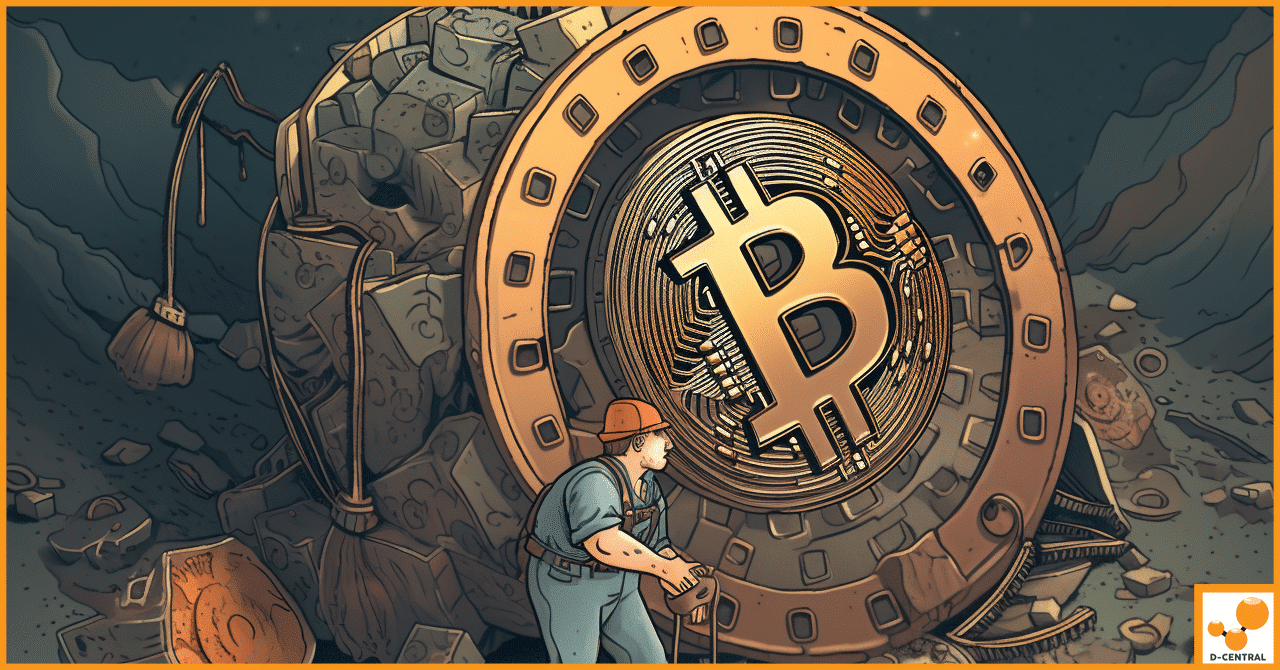
How to Mine Bitcoin: A Beginner’s Guide for the Non-Technical
Bitcoin mining is verifying transactions and adding them to the public blockchain, a decentralized ledger that records all Bitcoin transactions.
4479 Desserte Nord Autoroute 440, Laval, QC H7P 6E2

In the rapidly evolving digital age, Bitcoin mining has emerged as a cornerstone of the cryptocurrency revolution. This process is not just about creating new bitcoins; it’s a vital mechanism that maintains and secures the decentralized nature of the Bitcoin network. Mining involves validators, known as miners, who use powerful computers to solve complex cryptographic puzzles. Successfully solving these puzzles validates transactions and adds them to the blockchain, a public ledger that records all Bitcoin transactions.
The significance of Bitcoin mining transcends beyond the mere creation of new bitcoins. It represents a paradigm shift in how financial transactions and asset management can function, free from centralized control. This shift towards a decentralized financial system is particularly crucial in today’s economic landscape, where concerns over privacy, autonomy, and equitable access to financial services are increasingly prominent.
As the world becomes more digitally interconnected, the importance of Bitcoin and, by extension, Bitcoin mining, grows. It’s not only a lucrative opportunity for individuals and businesses willing to invest in the necessary resources but also a key player in shaping the future of finance. By securing the network and processing transactions, miners are at the forefront of a movement that champions transparency, security, and global access to financial resources.
Bitcoin mining, therefore, is more than just an industry—it’s a symbol of the potential for a more inclusive and efficient financial system. As we dive deeper into this guide, we’ll explore how you can be part of this exciting and transformative field, the intricacies of starting a Bitcoin mining business, and the various factors that make it a challenging yet rewarding venture.
Bitcoin mining is the process through which new bitcoins are created and transactions are confirmed and added to the public ledger, known as the blockchain. It’s a critical component of the maintenance and development of the blockchain ledger. Mining involves using specialized computer hardware to solve complex mathematical puzzles. This computational process is not just about minting new coins—it’s integral to the security and reliability of the Bitcoin network.
How does Bitcoin Mining work?
The essence of Bitcoin mining lies in the solving of cryptographic puzzles, which requires substantial computational power. Miners around the world compete to solve these puzzles, and the first one to crack it gets the opportunity to add a new block of transactions to the blockchain. In return for this service, miners are rewarded with newly minted bitcoins—this is known as the “block reward”. Additionally, miners also earn transaction fees paid by users for faster transaction processing.
The difficulty of these puzzles adjusts approximately every two weeks to ensure that a new block is added approximately every 10 minutes, a design that maintains the stability and security of the network.
Role in the Blockchain network
Bitcoin mining serves several critical roles in the blockchain network:
In summary, Bitcoin mining is not just the backbone of cryptocurrency generation but also a vital process that upholds the principles of decentralization, security, and transparency in the blockchain network. As such, it plays an indispensable role in the functioning and evolution of Bitcoin.
Before embarking on a Bitcoin mining venture, it’s crucial to conduct a thorough feasibility analysis. This involves evaluating the initial and ongoing costs, including the investment in mining hardware, electricity expenses, and potential maintenance costs. The feasibility study should also account for the computational power needed, as Bitcoin mining now requires significant processing capability to remain competitive.
Moreover, an understanding of the local electricity rates is vital since they can significantly impact profitability. The geographical location also plays a role, not just in terms of energy costs, but also in cooling requirements, as mining equipment generates substantial heat. Finally, consider the technical expertise required to set up and maintain a mining operation.
Understanding the Risks and Rewards
Bitcoin mining presents a unique blend of risks and rewards. The rewards come primarily in the form of block rewards and transaction fees. However, these rewards are subject to the volatility of Bitcoin’s price. The reduction in block rewards over time, a process known as halving, also impacts long-term profitability.
Risks include the potential for hardware failure, fluctuations in electricity costs, and regulatory changes that could affect the operation’s legality or profitability. There’s also the risk associated with the initial capital investment, as the rapid pace of technological advancement can render mining equipment obsolete.
The Impact of Market Volatility on Mining
Bitcoin’s price volatility significantly impacts mining profitability. When prices are high, the rewards are more lucrative, attracting more miners and increasing the network’s overall computational power. This, in turn, increases the difficulty level of mining, requiring more computational power to earn the same rewards.
Conversely, when Bitcoin’s price falls, the reduced profitability can lead miners to shut down their operations, especially those with higher operational costs. This reduction in mining activity can lead to a decrease in the network’s difficulty level. Miners must be prepared for these fluctuations and have a strategy to stay profitable or minimize losses during market downturns.
In essence, starting a Bitcoin mining business requires careful consideration of various factors, including costs, potential rewards, and market conditions. A thorough understanding of these aspects will help in making an informed decision about entering this field.
Before starting a Bitcoin mining operation, it’s crucial to understand the specific laws and regulations in your jurisdiction. Cryptocurrency laws vary significantly across different countries and even within regions of the same country. Some jurisdictions are very welcoming of Bitcoin mining, offering incentives and clear guidelines, while others may have restrictive or unclear regulatory landscapes.
It’s important to research and understand the legal status of cryptocurrencies and Bitcoin mining specifically. This includes regulations on cryptocurrency trading, use, and taxation. Being aware of these regulations can help avoid legal complications that could arise from non-compliance.
Necessary Permits and Licenses
Depending on your location, you may need specific permits and licenses to operate a Bitcoin mining business. This could include business licenses, environmental permits (especially if your operation consumes a significant amount of electricity), and possibly zoning permits if you’re setting up a large-scale mining operation.
It’s advisable to consult with local authorities or legal experts to understand what specific permits are required. This is particularly important if the mining operation is of significant scale or if it’s in an area where regulations around such activities are stringent.
Tax Implications and Reporting
Understanding the tax implications of Bitcoin mining is essential. In many jurisdictions, revenues generated from Bitcoin mining are considered taxable income. This might include both the rewards from mining (newly minted bitcoins) and transaction fees.
The method of reporting and the tax rate can vary. In some cases, mined bitcoins are treated as income at the time they are received, while in others, they are considered capital gains. It’s important to keep detailed records of your mining activities, as this information will be crucial for accurate tax reporting.
The value of Bitcoin is often converted into your local currency for tax purposes, and it’s essential to use the fair market value of Bitcoin on the day it was mined. Due to the volatility of Bitcoin, this can significantly impact the amount of tax owed.
Moreover, if your operation involves employees or large-scale infrastructure, other tax considerations like payroll taxes, property taxes, or business taxes may apply.
Given the complexity and evolving nature of cryptocurrency regulations and taxation, it’s highly recommended to seek advice from legal and tax professionals who specialize in this area. They can provide the most current and relevant advice, ensuring that your mining operation remains compliant with all local laws and tax requirements.
The first step in planning your Bitcoin mining operation is setting realistic and achievable goals. This involves defining what success looks like for your mining venture. Are you aiming for maximum profitability, supporting the Bitcoin network, or perhaps a combination of both? Setting clear goals will guide your decisions regarding the scale of your operation, the equipment you choose, and your approach to managing costs.
Consider both short-term and long-term goals. Short-term goals might include setting up your initial mining rig and beginning mining operations, while long-term goals could focus on expanding your mining power, diversifying your cryptocurrency holdings, or reinvesting profits into more advanced equipment.
Creating a Detailed Business Plan
A detailed business plan is vital for the success and sustainability of your Bitcoin mining operation. Your plan should cover several key areas:
Market Research and Understanding Competition
Conduct thorough market research to understand the current state of the Bitcoin mining industry. This research should include:
Planning your Bitcoin mining operation requires careful thought, detailed research, and a clear understanding of both the opportunities and challenges in the cryptocurrency mining landscape. By setting realistic goals, creating a detailed business plan, and conducting thorough market research, you can establish a foundation for a successful and profitable mining venture.
The startup costs for a Bitcoin mining business can be substantial and should be carefully evaluated. These costs primarily include:
Calculating Ongoing Operational Expenses
Ongoing expenses will significantly affect the long-term sustainability of your mining operation:
Funding Options and Financial Management
In summary, a well-planned budget and smart financial management are crucial for the success of a Bitcoin mining business. Estimating your startup costs accurately and keeping a close eye on ongoing expenses will help ensure your operation remains profitable. Additionally, exploring various funding options can provide the necessary capital to start and grow your mining venture.
Selecting the appropriate mining equipment is crucial for the efficiency and profitability of your Bitcoin mining operation. Here are the key factors to consider:
Types of Mining Hardware
Evaluating Performance and Efficiency
Purchasing vs. Leasing Options
The choice of mining equipment is a balance between budget, efficiency, and your specific mining goals. Whether you opt for ASICs or GPUs, consider the hash rate, energy consumption, and overall cost-effectiveness. Additionally, weigh the pros and cons of purchasing versus leasing based on your financial capacity and long-term mining strategy.
Once you have your hardware ready, the next crucial step is selecting and configuring the right mining software. This software connects your hardware to the Bitcoin network and enables it to interact with other miners, the blockchain, and, crucially, perform the mining operations.
Importance of a Stable and Fast Internet Connection
A reliable and fast internet connection is vital for successful Bitcoin mining. Since mining involves constant communication with the Bitcoin network and participation in a mining pool, any disconnection or slowdown in your internet can lead to missed opportunities and decreased efficiency.
Setting Up a Secure and Efficient Mining Environment
By carefully selecting the right mining software and setting up a stable and secure infrastructure, you can ensure that your Bitcoin mining operation runs efficiently and effectively. Remember, the foundation of a successful mining operation lies in its stability and security.
Electricity is the lifeblood of Bitcoin mining, powering the intensive computational work that mining hardware undertakes. The electricity requirements for a mining operation can be substantial, depending on the scale and the efficiency of the mining hardware used. High-performance ASIC miners, for example, consume a lot of power but offer significant computational power.
Strategies for Minimizing Energy Costs
Renewable Energy Options
Incorporating renewable energy sources not only helps in reducing operational costs but also aligns your mining operation with environmentally sustainable practices. Given the increasing focus on the environmental impact of Bitcoin mining, adopting green energy solutions can be a forward-thinking approach to running a more eco-friendly mining operation.
Maintaining your Bitcoin mining equipment is essential to ensure optimal performance and longevity of the hardware.
Protecting Your Mining Operation from Cyber Threats
Cybersecurity is a critical aspect of running a Bitcoin mining operation.
Hardware Upgrades and Management
Keeping your mining hardware updated is crucial to maintain competitiveness and efficiency.
Regular maintenance, robust security measures, and strategic hardware management are key to running a successful and secure Bitcoin mining operation. They not only ensure the smooth running of your mining rigs but also protect your investment and mined assets from physical and cyber threats.
Effective monitoring is essential in managing a Bitcoin mining operation. There are several tools and techniques that can help:
Analyzing Mining Performance
Analyzing your mining operation’s performance involves more than just looking at the daily Bitcoin yield. It includes:
Adjusting Strategies Based on Performance Data
Use the data you collect to inform your mining strategy:
Regular monitoring and analysis are key to maintaining an efficient and profitable Bitcoin mining operation. By staying informed and agile, you can make necessary adjustments to ensure the ongoing success of your mining venture.
Expanding a Bitcoin mining operation should be a strategic decision based on careful analysis and market conditions.
Diversifying Your Cryptocurrency Portfolio
Diversification is a key strategy to mitigate risk in the volatile cryptocurrency market.
Partnering with Other Businesses and Investors
Collaborating with others can provide additional resources and opportunities for growth.
In summary, scaling a Bitcoin mining business involves a balanced approach considering profitability, market conditions, and investment in infrastructure. Diversifying your cryptocurrency portfolio and seeking partnerships can provide additional stability and growth opportunities. Always ensure that expansion decisions are data-driven and align with your long-term business goals.
As we reach the conclusion of our comprehensive guide on starting a Bitcoin mining business, let’s recap the key takeaways and offer some parting words of advice for aspiring miners.
To the aspiring miners out there, remember that Bitcoin mining can be a rewarding venture, but it requires commitment, resilience, and a willingness to adapt to the ever-evolving cryptocurrency landscape. While the potential rewards can be significant, so too are the risks, particularly given the volatility of the cryptocurrency market and the competitive nature of mining.
Stay informed, be prepared for challenges, and approach your mining venture with a balance of enthusiasm and caution. And most importantly, never stop learning and adapting.
For more information, in-depth insights, and services related to Bitcoin mining, consider visiting D-Central Technologies. As a leader in the Bitcoin mining industry, D-Central Technologies offers a wealth of resources, expertise, and solutions to help you start and grow your Bitcoin mining operation. Whether you’re a seasoned miner or just starting out, D-Central Technologies is your go-to source for all things related to Bitcoin mining.
What is Bitcoin mining?
Bitcoin mining is the process by which new bitcoins are created and transactions are confirmed and added to the blockchain public ledger, through solving complex cryptographic puzzles using powerful computers.
How does Bitcoin mining work?
Miners compete to solve cryptographic puzzles, and the first miner to solve it gets to add a new block of transactions to the blockchain, earning a “block reward” in the form of new bitcoins and transaction fees.
What roles does Bitcoin mining serve in the blockchain network?
Bitcoin mining secures the network against fraudulent activities, verifies and processes transactions, maintains decentralization, and ensures network synchronization.
What initial costs are involved in starting a Bitcoin mining business?
The initial costs include investment in mining hardware, infrastructure setup, software, and operational setup costs like electricity and internet service.
What are the ongoing costs of operating a Bitcoin mining business?
Ongoing costs include electricity costs, hardware maintenance, cooling systems, and internet and other services.
How can I finance a Bitcoin mining business?
Options include using personal savings, taking out loans, seeking investors, or using existing cryptocurrency earnings.
What types of equipment are used for Bitcoin mining?
ASIC miners are specifically designed for Bitcoin mining and are the most efficient, while GPUs are more versatile and can mine various cryptocurrencies but are less efficient for Bitcoin.
What software is needed for Bitcoin mining?
Mining software like CGMiner, BFGMiner, and EasyMiner is necessary to connect mining hardware to the Bitcoin network.
How can I ensure the security of my Bitcoin mining operation?
Implement robust security measures such as secure network connections, reputable wallets, two-factor authentication, regular backups, and keep software updated.
What factors should I consider before scaling my Bitcoin mining business?
Consider profitability, market conditions, necessary infrastructure upgrades, investment in new hardware, and a gradual approach to expansion. Diversifying your cryptocurrency portfolio and partnering with other businesses are also important aspects.
DISCLAIMER: D-Central Technologies and its associated content, including this blog, do not serve as financial advisors or official investment advisors. The insights and opinions shared here or by any guests featured in our content are provided purely for informational and educational purposes. Such communications should not be interpreted as financial, investment, legal, tax, or any form of specific advice. We are committed to advancing the knowledge and understanding of Bitcoin and its potential impact on society. However, we urge our community to proceed with caution and informed judgment in all related endeavors.
Related Posts

Bitcoin mining is verifying transactions and adding them to the public blockchain, a decentralized ledger that records all Bitcoin transactions.

Bitcoin mining holds a place of paramount importance. It is the engine that drives the Bitcoin network, a complex process

In the digital tapestry of the 21st century, Bitcoin emerges not merely as a cryptocurrency but as a profound embodiment